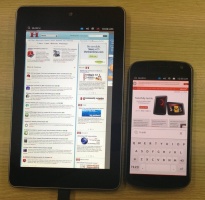Ubuntu for tablets and smartphones previewed

![]() Ubuntu Touch on the bench, on a Nexus 7 and Galaxy Nexus, at The H
Canonical has, as promised, delivered the "Touch Developer Preview" images and tools, an early, partially functional, release of Ubuntu for Phones and for Tablets. The preview images, in a directory labelled "mwc_demo", presumably because it was also created for demonstrating features of the new mobile operating system at Mobile World Congress next week, includes the basic shell of the operating system, Gallery, Phone, Camera, Browser, Media Player and Notepad. It also comes with a number of non-functional app mockups, for Music Player, Weather, Calculator and the commercial title Ski Safari and is loaded with example contacts, pictures, videos and music metadata.
Ubuntu Touch on the bench, on a Nexus 7 and Galaxy Nexus, at The H
Canonical has, as promised, delivered the "Touch Developer Preview" images and tools, an early, partially functional, release of Ubuntu for Phones and for Tablets. The preview images, in a directory labelled "mwc_demo", presumably because it was also created for demonstrating features of the new mobile operating system at Mobile World Congress next week, includes the basic shell of the operating system, Gallery, Phone, Camera, Browser, Media Player and Notepad. It also comes with a number of non-functional app mockups, for Music Player, Weather, Calculator and the commercial title Ski Safari and is loaded with example contacts, pictures, videos and music metadata.
Canonical makes it clear this is not an operating system to be installed for daily use and notes the release is for non-commercial purposes only; the preview also only supports "limited" voice and SMS over GSM and there is no CDMA, LTE, airplane mode, emergency call support, locked SIM PIN support, SIM filesystem, Speakerphone or MMS. The preview is available for the Google Galaxy Nexus and Nexus 4 smartphones and the Nexus 7 and 10 tablets. The Google devices were selected because they are easily unlocked; no other devices are currently supported.
Installing the developer preview is a simple process, documented on the Touch/Install page of the Ubuntu wiki. Developers will require an Ubuntu desktop system, 12.04 Precise, 12.10 Quantal or 13.04 Raring, to install as the tools are packaged as a PPA archive. A developer adds the PPA and installs the tools, unlocks the smartphone or tablet, turns on USB debugging and runs phablet-flash -b – the rest of the process is automatic with appropriate images for the device being downloaded from Canonical's servers and pushed to the Google devices over USB.
Initial testing at The H found a heavily un-optimised operating system which will need a lot of work in the next nine months if Canonical are to deliver on schedule. The Nexus 7 tablet variant looked very much like the phone edition scaled up, only working in portrait and lacking the multi-user logins; Canonical says the Nexus 10 version works in landscape and thus enables the "Sidestage" multitasking feature. Keyboards lack predictive text options and navigation gestures involve a mix of swiping and precision that could take a lot of practice to get used to.
In working with web applications such as Twitter, it was impossible to post a new tweet as the button to do this was in the top right hand corner of the display and touching in that edge is currently interpreted as wanting to swipe to another application. App mockups and demonstration data tend to make the device harder to explore for a developer; Canonical offer instructions on how to SSH into the device to remove the latter. The company has delivered what it set out to do at this point; the release is a developer preview with all the sharp edges and trapdoors that this entails. Users who are curious can easily install the images, but should be ready to reload a working Android image to their devices if they rely on them.
(djwm)
![Kernel Log: Coming in 3.10 (Part 3) [--] Infrastructure](/imgs/43/1/0/4/2/6/7/2/comingin310_4_kicker-4977194bfb0de0d7.png)

![Kernel Log: Coming in 3.10 (Part 3) [--] Infrastructure](/imgs/43/1/0/4/2/3/2/3/comingin310_3_kicker-151cd7b9e9660f05.png)
















